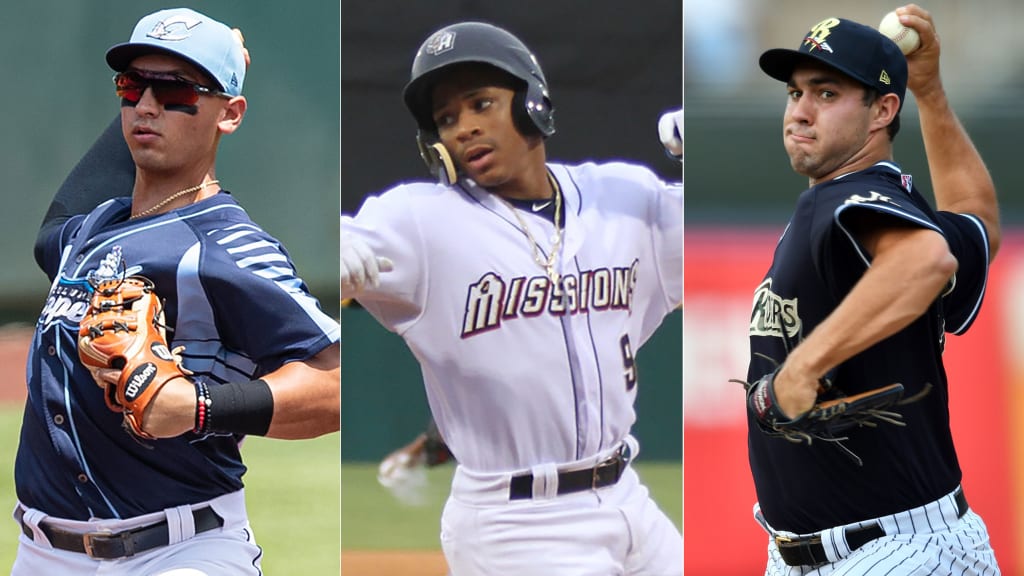
MILWAUKEE -- The Brewers traded for Indians Minor League infielder Mark Mathias on Wednesday and added him to the 40-man roster, along with outfielder Corey Ray and reliever J.P. Feyereisen, to protect those players from next month's Rule 5 Draft.
Ray is ranked fourth on MLB Pipeline's list of the top 30 Milwaukee prospects, but three other members of that list were left unprotected: 2018 Brewers Minor League Pitcher of the Year Zack Brown (third), infielder Lucas Erceg (14th) and pitcher Braden Webb (18th).
That means Brown, Erceg and Webb would be among the Brewers' Minor Leaguers available in the Rule 5 Draft to other teams, who must keep any drafted players on the Major League roster next season or offer them back.
With Wednesday's moves, the Brewers' 40-man roster stood at 36.
"These are really tough decisions," Brewers president of baseball operations David Stearns said. "You always want to protect more players than you can."
The Brewers traded Rookie-league catcher Andres Melendez to Cleveland for the 25-year-old Mathias, who hit .269/.355/.442 with 45 extra-base hits in 2019 at Triple-A Columbus. He has played primarily second base in the pro ranks but also has starts at third base and shortstop, giving him a chance to be the next Hernán Pérez, who was cut loose early in the offseason.
"It's important for us to have an optionable infielder who can go up and down with positional versatility," Stearns said. "We know with some of the roster changes we've had, with trading [Mauricio] Dubón at the last Deadline, that we were going to need to find an optionable infielder who can provide depth and hopefully contribute at the Major League level."
Ray, 25, was an expected addition despite coming off a disappointing season in which he logged a .654 OPS for three affiliates. The year before that, the 2016 first-round pick was the Brewers' 2018 Minor League Player of the Year after hitting .239/.323/.477 with 32 doubles, seven triples and 27 home runs in 135 games for Double-A Biloxi.
Ray was hoping to build on that momentum in 2019, but he was slowed by a fractured right hand that required a monthlong stay on the injured list early in the year. He was passed on the organizational depth chart by Trent Grisham and Tyrone Taylor, both of whom made their Major League debut during the second half of the season.
Feyereisen, 26, is a native of River Falls, Wis., who originally was drafted by the Indians out of the University of Wisconsin-Stevens Point. The Brewers acquired him in an early September trade with the Yankees after he struck out 13.8 batters per nine innings and logged a 2.49 ERA over 61 1/3 innings at Triple-A Scranton/Wilkes-Barre in 2019.
"We think he'll [compete] for a spot in our bullpen this spring," Stearns said. "He really changed who he was last year and got a ton more swing and miss."
Just as interesting as who the Brewers opted to protect was who they risk losing. Brown was 9-1 with a 2.44 ERA in 125 2/3 innings at Double-A in 2018, when he was named Milwaukee's top Minor League pitcher. But instead of following in the footsteps of previous winners Brandon Woodruff (2016) and Corbin Burnes ('17) -- each made his Major League debut the following year -- Brown regressed after a promotion to Triple-A. He was 3-7 with a 5.79 ERA in 116 2/3 innings and spent time at the Brewers' pitching lab in Phoenix trying to get straightened out.
"We still have high hopes for Zack Brown," Stearns said. "Ultimately, he didn't perform the way we had hoped, the way he had hoped and expected, at Triple-A last year, and that certainly influenced our decision. But he'll get a chance again [next year] to repeat that level, and it's certainly our expectation that he can regain that effectiveness that he demonstrated in Double-A the year before."
Asked about the risk that another team could take a flier on Brown and cost the Brewers a commodity -- pitching prospects -- that they can ill afford to lose, Stearns said, "That's always a risk. ... We do our best to determine who has selection risk, who doesn't have as much selection risk, and who we think is capable of immediately contributing at the Major League level. We've been right most of the time. We've been wrong occasionally. I think that's similar to most teams. These are not 100 percent easy, clear decisions to make on some players."



